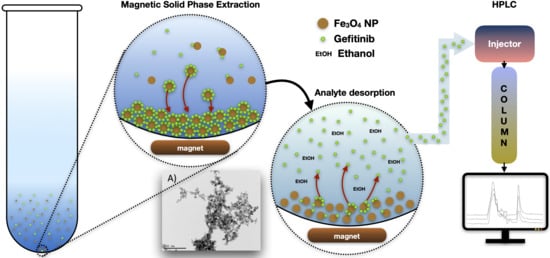Preconcentration and Detection of Gefitinib Anti-Cancer Drug Traces from Water and Human Plasma Samples by Means of Magnetic Nanoparticles
Abstract
:1. Introduction
2. Materials and Methods
2.1. Chemicals and Reagents
2.2. Measurement Methods
2.3. Synthesis of Fe3O4 Nanoparticles
2.4. Optimum Conditions for MSPE of Gefitinib
2.5. Extraction of GEF from Water and Plasma Samples
3. Results and Discussion
3.1. Characterization of the Synthesized Fe3O4 Magnetic Nanoparticles
3.2. Optimization of MSPE Mechanism and Procedure
3.2.1. Effect of the Sample’s pH
3.2.2. Effect of Concentration of SDS
3.2.3. Effect of Amount of Adsorbent
3.2.4. Effect of Extraction Time
3.2.5. Desorption Conditions
3.2.6. Extraction Procedure from Spiked Plasma Samples
3.3. Analytical Performance
3.4. Application of the Proposed Method to the Real Plasma Sample
3.5. Comparison with Other Reported Methods
4. Conclusions
Author Contributions
Funding
Acknowledgments
Conflicts of Interest
References
- Yang, Y.; Zhou, J.; Li, X.; Zhao, L.; Cheng, Y.; Lin, Y.; Wang, J.; Wei, L.; Dong, Y.; Wang, J. Gefitinib enhances sensitivity of endometrial cancer cells to progestin therapy via dual-specificity phosphatase 1. Oncotarget 2017, 8, 115360. [Google Scholar] [CrossRef] [Green Version]
- European Directorate for the Quality of Medicines & Healthcare (EDQM). European Pharmacopoeia, 7th ed.; European Directorate for the Quality of Medicines & Healthcare (EDQM): Strasbourg, France, 2013. [Google Scholar]
- Cohen, M.H.; Williams, J.A.; Sridhara, R.; Chen, G.; Pazdur, R. FDA drug approval summary: Gefitinib (ZD1839)(Iressa®) tablets. Oncologist 2003, 8, 303–306. [Google Scholar] [CrossRef] [PubMed]
- Savale, S.A.G.A.R. Simultaneous determination of curcumin and gefitinib in pure form by using UV spectrophotometric method. Hygeia J. Drugs Med. 2017, 9, 1–8. [Google Scholar] [CrossRef]
- Patel, C.R.; Desai, K.B.; Joshi, K.A.; Pradhan, P.K.; Dey, S.; Upadhyay, U.M. Determination of simvastatin and gefitinib in binary mixture using spectrophotometric, chemometric assisted spectrophotometric and high performance liquid chromatographic methods. World J. Pharm. Res. 2014, 3, 642–657. [Google Scholar]
- Ks, N.S.; Pai, G.; Verma, R.; Ananthakrishna, P.; Kumar, L. Validation of HPLC method for quantitative determination of gefitinib in polymeric nanoformulation. Pharm. Chem. J. 2017, 51, 159–163. [Google Scholar] [CrossRef]
- Wu, X.; Luo, A.; Ye, L.; Chen, Z.; Wan, Q.; Fan, H.; Hu, Q. Simultaneous determination of gefitinib and its related substances in raw material drugs by reversed-phase high performance liquid chromatography. J. Instrum. Anal. 2016, 35, 35–41. [Google Scholar] [CrossRef]
- Wang, Y.; Ren, K.; Yao, Y.; Zhang, R.; Zhou, J.; Zheng, H. Determination and pharmacokinetic study of gefitinib in rat plasma by HPLC. Lat. Am. J. Pharm. 2016, 35, 429–433. [Google Scholar]
- Merienne, C.; Rousette, M.; Ducint, D.; Castaing, N.; Titier, K.; Molimard, M.; Bouchet, S. High throughput routine determination of 17 tyrosine kinase inhibitors by LC–MS/MS. J. Pharm. Biomed. Anal. 2018, 150, 112–120. [Google Scholar] [CrossRef]
- Noh, C.K.; Lee, J.H.; Kim, M.S.; Maeng, H.J.; Chung, S.J. Simultaneous quantification of volitinib and gefitinib in rat plasma by HPLC–MS/MS for application to a pharmacokinetic study in rats. J. Sep. Sci. 2017, 40, 3782–3791. [Google Scholar] [CrossRef]
- Zheng, N.; Zhao, C.; He, X.R.; Jiang, S.T.; Han, S.Y.; Xu, G.B.; Li, P.P. Simultaneous determination of gefitinib and its major metabolites in mouse plasma by HPLC–MS/MS and its application to a pharmacokinetics study. J. Chromatogr. B 2016, 1011, 215–222. [Google Scholar] [CrossRef]
- Lv, Y.; Sun, Y.; Fu, J.; Kong, L.; Han, S. Screening anti-allergic components of Astragali Radix by using LAD2 cell membrane chromatography coupled online with UHPLC-ESI-MS/MS method. Biomed. Chromatogr. 2017, 31, e3806. [Google Scholar] [CrossRef]
- Vasconcelos, I.; Fernandes, C. Magnetic solid phase extraction for determination of drugs in biological matrices. TrAC Trends Anal. Chem. 2017, 89, 41–52. [Google Scholar] [CrossRef]
- Heidari, H.; Limouei-Khosrowshahi, B. Magnetic solid phase extraction with carbon-coated Fe3O4 nanoparticles coupled to HPLC-UV for the simultaneous determination of losartan, carvedilol, and amlodipine besylate in plasma samples. J. Chromatogr. B 2019, 1114, 24–30. [Google Scholar] [CrossRef] [PubMed]
- Farajzadeh, M.A.; Yadeghari, A.; Abbaspour, M. Dispersive solid phase extraction using magnetic nanoparticles performed in a narrow-bored tube for extraction of atorvastatin, losartan, and valsartan in plasma. Adv. Pharm. Bull. 2019, 9, 138–146. [Google Scholar] [CrossRef] [PubMed]
- Satyanarayana, P.V.V.; Murali, M. Development and validation of LC method for the estimation of gefitinib in pharmaceutical dosage form. Int. J. Res. Pharm. Chem. 2011, 1, 338–341. [Google Scholar]
- Chahbouni, A.; Den Burger, J.C.G.; Vos, R.M.; Sinjewel, A.; Wilhelm, A.J. Simultaneous quantification of erlotinib, gefitinib, and imatinib in human plasma by liquid chromatography tandem mass spectrometry. Ther. Drug Monit. 2009, 31, 683–687. [Google Scholar] [CrossRef] [Green Version]
- Zhao, M.; Hartke, C.; Jimeno, A.; Li, J.; He, P.; Zabelina, Y.; Hidalgo, M.; Baker, S.D. Specific method for determination of gefitinib in human plasma, mouse plasma and tissues using high performance liquid chromatography coupled to tandem mass spectrometry. J. Chromatogr. B 2005, 819, 73–80. [Google Scholar] [CrossRef]
- Guan, S.; Chen, X.; Wang, F.; Xin, S.; Feng, W.; Zhu, X.; Liu, S.; Zhuang, W.; Zhou, S.; Huang, M.; et al. Development and validation of a sensitive LC–MS/MS method for determination of gefitinib and its major metabolites in human plasma and its application in non-small cell lung cancer patients. J. Pharm. Biomed. Anal. 2019, 172, 364–371. [Google Scholar] [CrossRef]
- Maity, D.; Agrawal, D.C. Synthesis of iron oxide nanoparticles under oxidizing environment and their stabilization in aqueous and non-aqueous media. J. Magn. Magn. Mater. 2007, 308, 46–55. [Google Scholar] [CrossRef]
- Maleki, S.; Falaki, F.; Karimi, M. Synthesis of SDS micelles-coated Fe3O4/SiO2 magnetic nanoparticles as an excellent adsorbent for facile removal and concentration of crystal violet from natural water samples. J. Nanostructure Chem. 2019, 9, 129–139. [Google Scholar] [CrossRef] [Green Version]
- Yamini, Y.; Faraji, M. Extraction and determination of trace amounts of chlorpromazine in biological fluids using magnetic solid phase extraction followed by HPLC. J. Pharm. Anal. 2014, 4, 279–285. [Google Scholar] [CrossRef] [Green Version]
- Beiraghi, A.; Pourghazi, K.; Amoli-Diva, M.; Razmara, A. Magnetic solid phase extraction of mefenamic acid from biological samples based on the formation of mixed hemimicelle aggregates on Fe3O4 nanoparticles prior to its HPLC-UV detection. J. Chromatogr. B 2014, 945, 46–52. [Google Scholar] [CrossRef] [PubMed]
- Zhu, L.; Pan, D.; Ding, L.; Tang, F.; Zhang, Q.; Liu, Q.; Yao, S. Mixed hemimicelles SPE based on CTAB-coated Fe3O4/SiO2 NPs for the determination of herbal bioactive constituents from biological samples. Talanta 2010, 80, 1873–1880. [Google Scholar] [CrossRef] [PubMed]
- Bergman, E.; Forsell, P.; Persson, E.M.; Knutson, L.; Dickinson, P.; Smith, R.; Swaisland, H.; Farmer, M.R.; Cantarini, M.V.; Lennernas, H. Pharmacokinetics of gefitinib in humans: The influence of gastrointestinal factors. Int. J. Pharm. 2007, 341, 134–142. [Google Scholar] [CrossRef]
- Tadros, T. Hemi-micelles and their formation. In Encyclopedia of Colloid and Interface Science; Springer: Berlin/Heidelberg, Germany, 2013. [Google Scholar] [CrossRef]
- Adivi, F.G.; Hashemi, P.; Tehrani, A.D. Agarose-coated Fe3O4@SiO2 magnetic nanoparticles modified with sodium dodecyl sulfate, a new promising sorbent for fast adsorption/desorption of cationic drugs. Polym. Bull. 2019, 76, 1239–1256. [Google Scholar] [CrossRef]
- Guo, X.; Wu, H.; Guo, S.; Shi, Y.; Du, J.; Zhu, P.; Du, L. Highly sensitive fluorescence methods for the determination of alfuzosin, doxazosin, terazosin and prazosin in pharmaceutical formulations, plasma and urine. Anal. Sci. 2016, 32, 763–768. [Google Scholar] [CrossRef] [PubMed] [Green Version]
- Liu, Q.; Shi, J.; Wang, T.; Guo, F.; Liu, L.; Jiang, G. Hemimicelles/admicelles supported on magnetic graphene sheets for enhanced magnetic solid-phase extraction. J. Chromatogr. A 2012, 1257, 1–8. [Google Scholar] [CrossRef]
- ICH, I. ICH Harmonized Tripartite Guideline: Validation of Analytical Procedures. In Text and Methodology; International Conference on Harmonisation of Technical Requirements for Registrations of Pharmaceuticals for Human Use (ICH): Geneva, Switzerland, 2005. [Google Scholar]
- Swaisland, H.C.; Smith, R.P.; Laight, A.; Kerr, D.J.; Ranson, M.; Wilder-Smith, C.H.; Duvauchelle, T. Single-dose clinical pharmacokinetic studies of gefitinib. Clin. Pharmacokinet. 2005, 44, 1165–1177. [Google Scholar] [CrossRef]
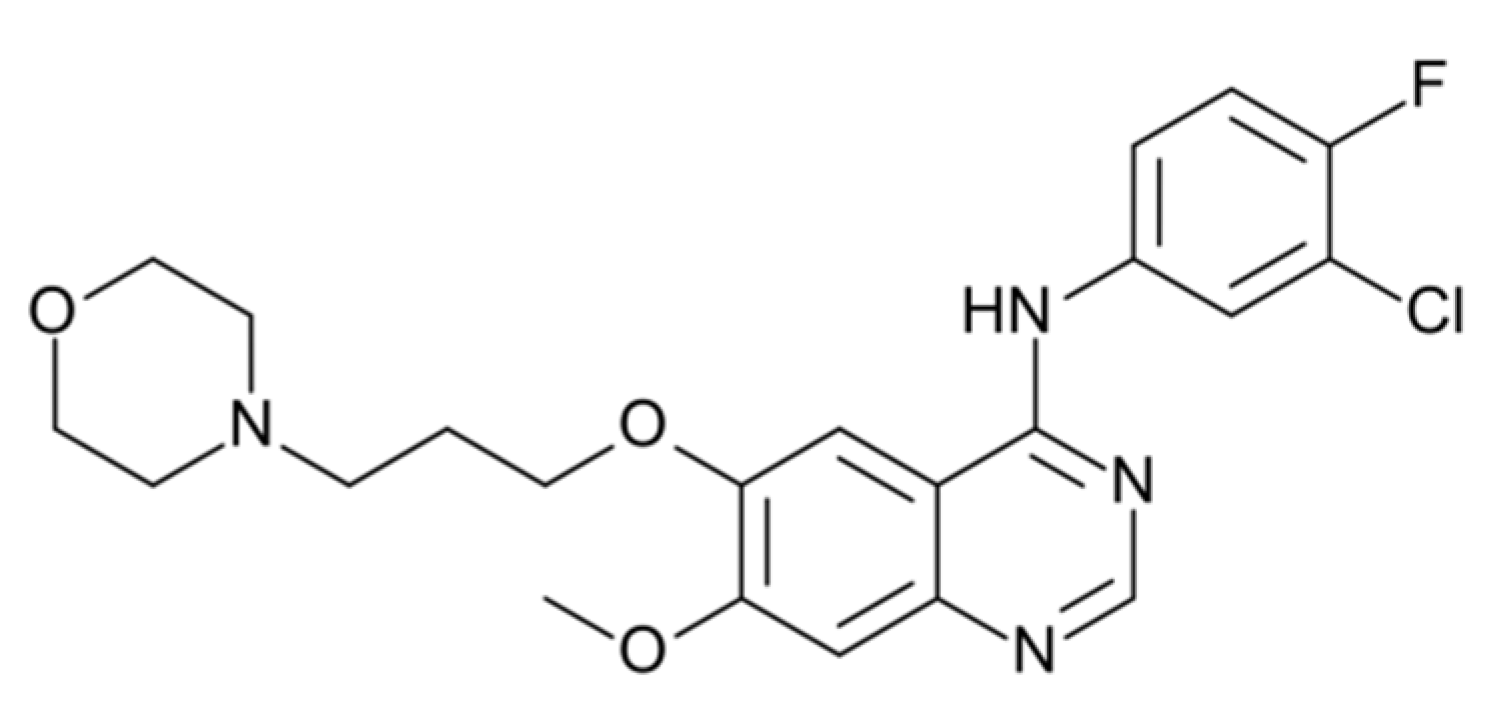

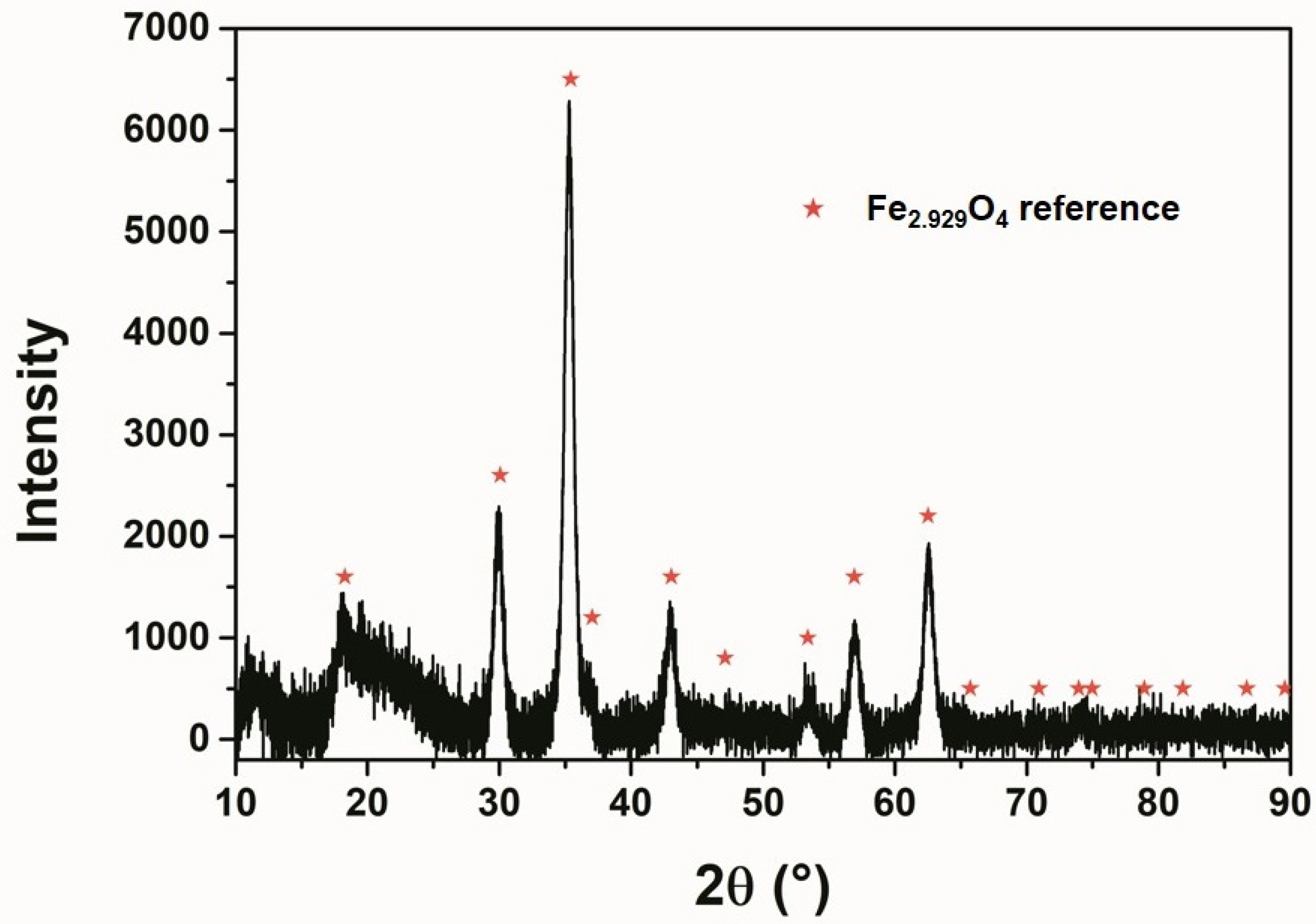

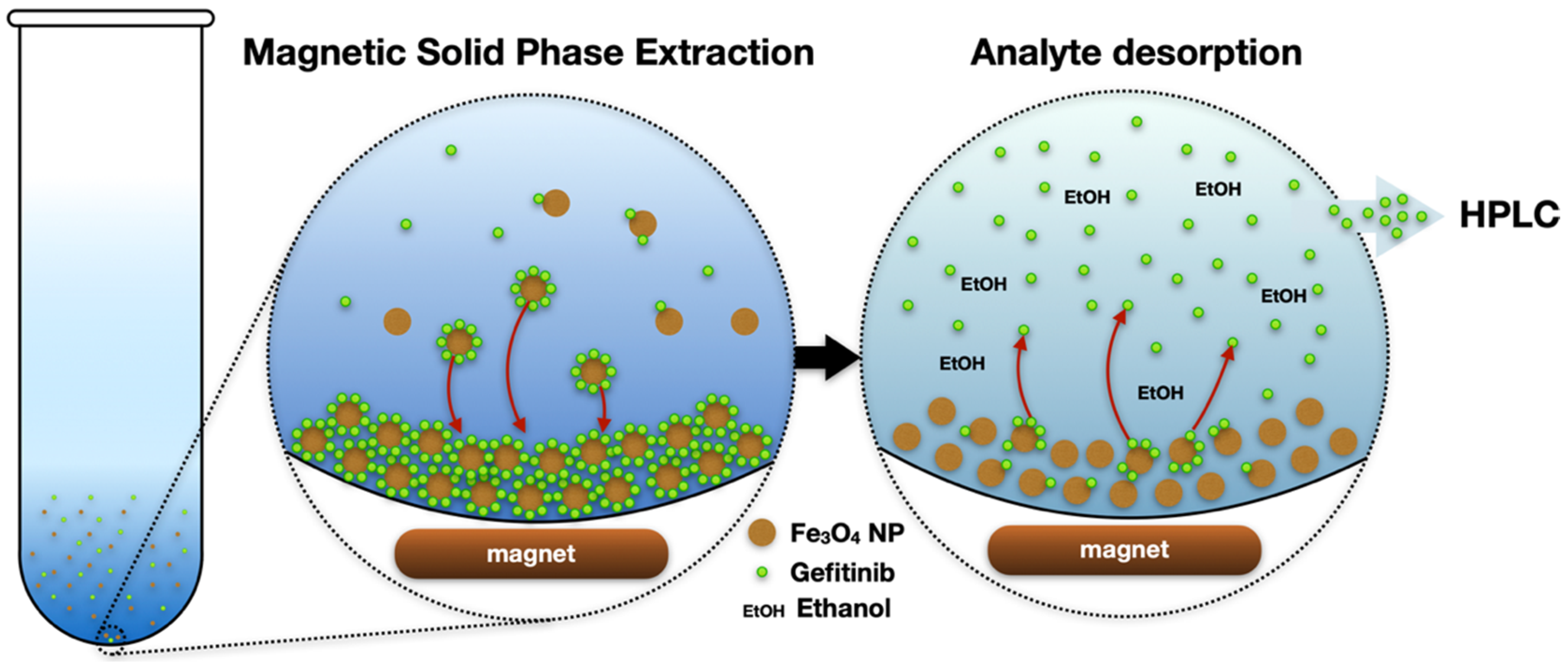
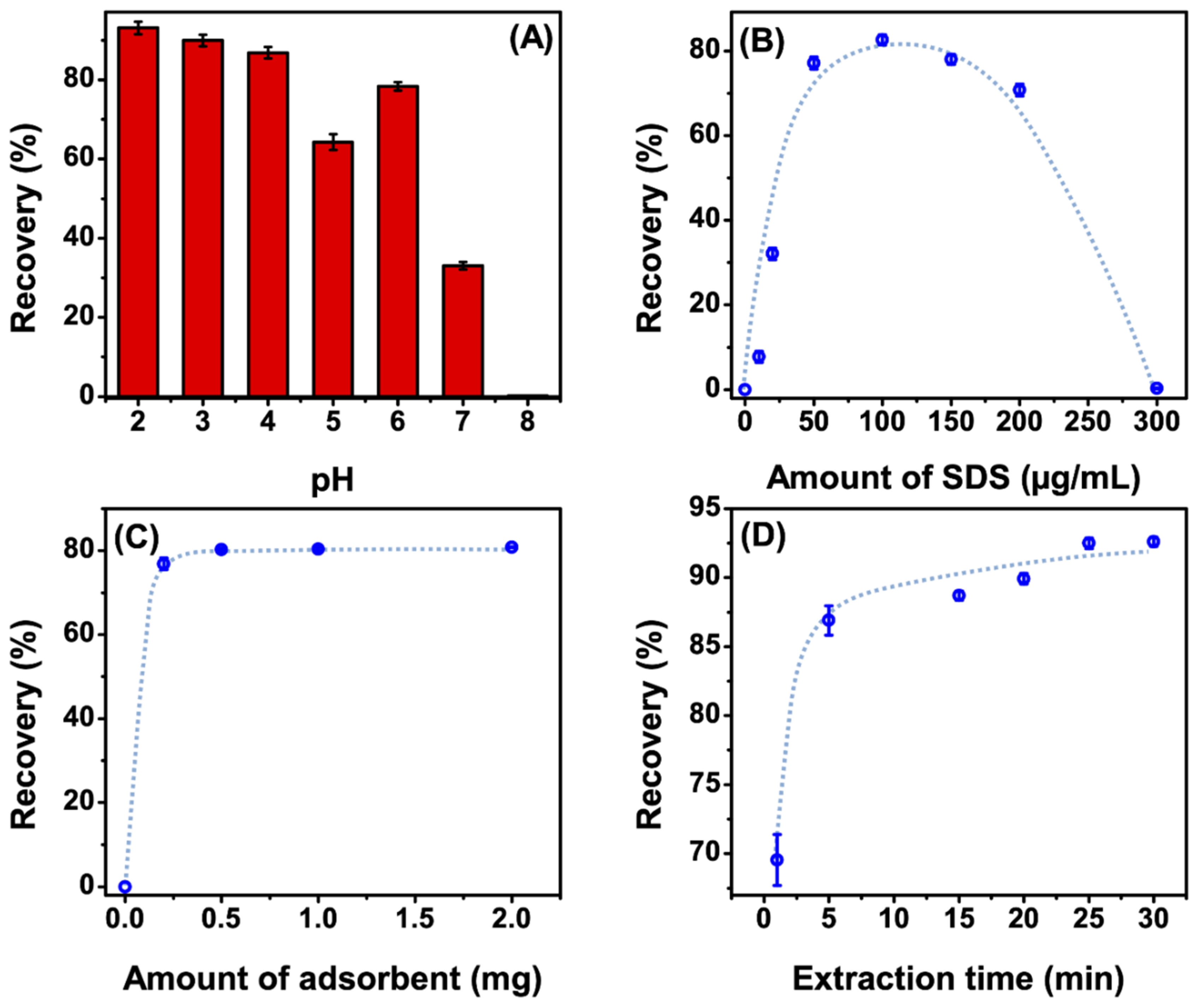
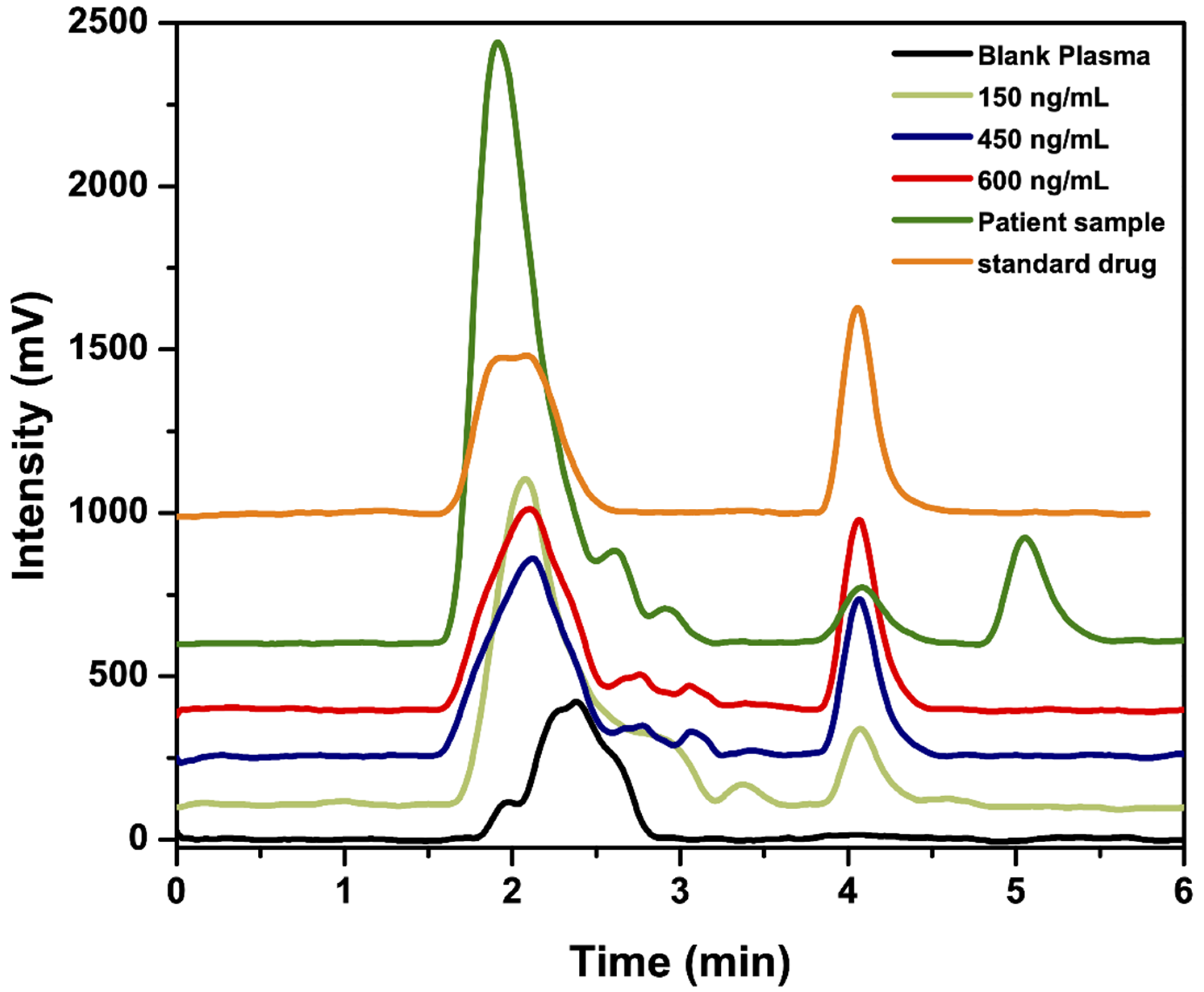
| Matrix | Extraction Method | Detection System | Extraction Time (min) | LOD (ng/mL) | Linear Range (ng/mL) | %RSD | Ref. |
|---|---|---|---|---|---|---|---|
| Water | SPE | HPLC-UV | 20 | 4.6 | 15–300 | 1.0 | This work |
| Human Plasma | SPE | HPLC-UV | 20 | 25.0 | 80–600 | 1.1 | This work |
| Polymeric nano-formulation | - | HPLC-UV | - | 37.8 | 200–1200 | <1 | [6] |
| Tablet | - | HPLC-UV | - | 90 | 5000–25,000 | 0.877 | [16] |
| Human Plasma | LLE | HPLC-MS | 15 | - | 5–3000 | <5 | [17] |
| Human Plasma | Protein precipitation | HPLC-MS | 10 | - | 1–1000 | <15 | [18] |
| Rat Plasma | Protein precipitation | HPLC-MS | 10 | - | 5–1000 | <15 | [18] |
| Human Plasma | LLE | LC-MS/MS | >30 | - | 0.5–1000 | <15 | [19] |
| Matrix | LOD (ng/mL) | LOQ (ng/mL) | %RSD | %Error | Extraction Percentage (%) | Linear Range (ng/mL) | R2 | |
|---|---|---|---|---|---|---|---|---|
| Intra-Day | Inter-Day | |||||||
| Water | 4.6 | 15.0 | 0.8 | 0.9 | 0.55 | 94.0 | 15–300 | 0.9999 |
| Human plasma | 25.5 | 80.0 | 1.3 | 1.7 | 0.60 | 87.1 | 80–600 | 0.9997 |
| Intra-Day Precision | Inter-Day Precision | ||||||
|---|---|---|---|---|---|---|---|
| Conc. Taken (ng/mL) | Conc. Found (ng/mL) | % Found | Conc. Taken (ng/mL) | Conc. Found (ng/mL) | % Found | ||
| Water samples | 50.00 | 50.62 | 101.24 | 50.00 | 50.62 | 101.24 | |
| 150.00 | 151.99 | 101.33 | 150.00 | 152.63 | 101.75 | ||
| 300.00 | 299.97 | 99.99 | 300.00 | 299.76 | 99.92 | ||
| ± SD | 100.85 ± 0.75 | 100.95 ± 0.94 | |||||
| %RSD | 0.75 | 0.94 | |||||
| %Error | 0.43 | 0.54 | |||||
| Plasma samples | 150.00 | 147.76 | 98.51 | 150.00 | 149.86 | 99.91 | |
| 450.00 | 454.54 | 101.01 | 450.00 | 452.43 | 100.54 | ||
| 600.00 | 596.94 | 99.49 | 600.00 | 584.16 | 97.36 | ||
| ± SD | 99.67 ± 1.26 | 99.27 ± 1.70 | |||||
| %RSD | 1.26 | 1.70 | |||||
| %Error | 0.73 | 0.98 | |||||
© 2020 by the authors. Licensee MDPI, Basel, Switzerland. This article is an open access article distributed under the terms and conditions of the Creative Commons Attribution (CC BY) license (http://creativecommons.org/licenses/by/4.0/).
Share and Cite
Borg, H.; Zámbó, D.; Elmansi, H.; Hashem, H.M.; Nasr, J.J.; Walash, M.I.; Bigall, N.C.; Belal, F. Preconcentration and Detection of Gefitinib Anti-Cancer Drug Traces from Water and Human Plasma Samples by Means of Magnetic Nanoparticles. Nanomaterials 2020, 10, 1196. https://doi.org/10.3390/nano10061196
Borg H, Zámbó D, Elmansi H, Hashem HM, Nasr JJ, Walash MI, Bigall NC, Belal F. Preconcentration and Detection of Gefitinib Anti-Cancer Drug Traces from Water and Human Plasma Samples by Means of Magnetic Nanoparticles. Nanomaterials. 2020; 10(6):1196. https://doi.org/10.3390/nano10061196
Chicago/Turabian StyleBorg, Hadeer, Dániel Zámbó, Heba Elmansi, Heba M. Hashem, Jenny Jehan Nasr, Mohammed I. Walash, Nadja C. Bigall, and Fathalla Belal. 2020. "Preconcentration and Detection of Gefitinib Anti-Cancer Drug Traces from Water and Human Plasma Samples by Means of Magnetic Nanoparticles" Nanomaterials 10, no. 6: 1196. https://doi.org/10.3390/nano10061196
APA StyleBorg, H., Zámbó, D., Elmansi, H., Hashem, H. M., Nasr, J. J., Walash, M. I., Bigall, N. C., & Belal, F. (2020). Preconcentration and Detection of Gefitinib Anti-Cancer Drug Traces from Water and Human Plasma Samples by Means of Magnetic Nanoparticles. Nanomaterials, 10(6), 1196. https://doi.org/10.3390/nano10061196




